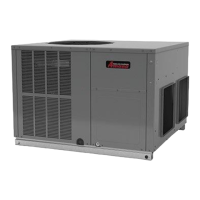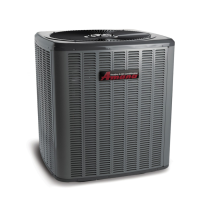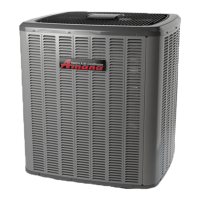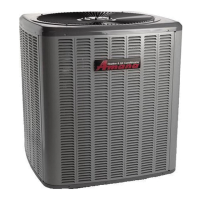9
Red R (24V)
Green G (fan)
Orange O (Rev. Valve)
White W1 (Heat, Aux Heat Stage 1)*
Brown W2 (Heat, Aux Heat Stage 2)*
Purple Y1 (Compressor Stage 1)
Yellow Y2 (Compressor Stage 2)
Blue C (24V Common)
*Optional eld installed heat connections
Thermostats must be set to energize “G” during cooling.
This is default on most thermostats.
A diagram detailing the internal wiring of this unit is located
on the electrical box cover. If any of the original wire
supplied with the appliance must be replaced, the wire
gauge and insulation must be the same as the original
wiring.
1. For branch circuit wiring (main power supply to unit
disconnect), the minimum wire size for the length
of the run can be determined from N.E.C., local
building codes, and using the circuit ampacity found
on the unit rating plate. From the unit disconnect to
unit, the smallest wire size allowable may be used
for the ampacity, as the Disconnect MUST be in
accordance with Federal, State, and Local jurisdiction
requirements.
2. Wire size based on 60°C rated wire insulation and
30°C Ambient Temperature (86°F).
3. For more than 3 conductors in a raceway or cable,
see the N.E.C. for derating the ampacity of each
conductor.
Begin with power turned o at ALL disconnects.
WARNING
1. Turn thermostat system switch to “Cool,” and fan
switch to “Auto” and turn temperature setting as high
as it will go.
2. Inspect all registers and set them to the normal open
position.
3. Turn on the electrical supply at the disconnect.
4. Turn the fan switch to the “ON” position. The blower
should begin ramping up immediately.
5. Turn the fan switch to “AUTO” position. The blower
should begin ramping down after an approximate
60-second delay.
6. Slowly lower the cooling temperature until the unit
starts. The compressor, blower, and fan should now
be operating. Allow the unit to run 10 minutes, make
sure cool air is being supplied by the unit.
7. Turn the temperature setting to the highest position,
stopping the unit. The indoor blower will continue to
run for approximately 60 seconds.
8. Turn the thermostat system switch to “OFF” and
disconnect all power when servicing the unit.
WARNING
1. Check the cooling mode for the heat pump in the
same manner as above. The reversing valve
is energized when the thermostat is placed in
the cooling position. A clicking sound should be
noticeable from the reversing valve. By lowering the
temperature setting to call for cooling, the contactor
is energized. The compressor, blower and fan should
then be running. After the colling mode is checked
out, turn the thermostat system switch to “OFF”.
2. Turn the thermostat system switch to “HEAT” and fan
switch to “AUTO”.
3. Slowly raise the heating temperature setting. When
the heating rst stage makes contact, stop raising
the temperature setting. The compressor, blower and
fan should now be running with the reversing valve in
the de-energized (heating) position. After giving the
unit time to settle out, make sure the unit is supplying
heated air.
4. If the outdoor ambient is above 80°F, the unit may trip
on its high-pressure cutout when in heating mode.
The compressor should stop. The heating cycle
must be thoroughly checked, so postpone the test to
another day when conditions are more suitable but,
DO NOT FAIL TO TEST.
5. If unit operates properly in the heating cycle, raise the
temperature setting until the heating second stage
makes contact. Supplemental resistance heat, if
installed should now come on. Make sure it operates
properly.

